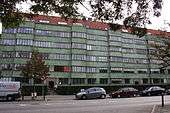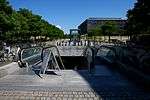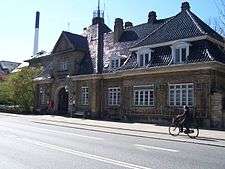Fasanvej
Søndre and Nordre Fasanvej (literally South and North Pheasant Road) are two streets which form a long south--to-northnorth oriented artery through Frederiksberg, an independent municipality completely surrounded by larger Copenhagen Municipality in Copenhagen, Denmark. The southern part of the street is surrounded by large green spaces and attractive residential neighbourhoods while its northern part, which enters the Nørrebro and North-West districts of Copenhagen, is dominated by former industry. The street takes its name after Fasangården, a former royal pheasantry, in Frederiksberg Park.
 Nordre Fasanvej with the Novozymes factory | |
| Length | 2,000 m (7,000 ft) |
|---|---|
| Location | Frederiksberg Bispebjerg, Nørrebro |
| Postal code | 2000 (No. 1-221), 220 (222-263) and 2400 (254- |
| Nearest metro station | Fasanvej, Nørrebro |
| Coordinates | 55°41′19.32″N 12°31′41.88″E |
Location
Søndre Fasanvej begins at Valby Langgade and continues along the western margin of Søndermarken and Frederiksberg Gardens to Smallegade, passing Roskildevej on the way. It then continues as Nordre Fasanvej, passing several major arteries, including Nylandsvej, Godthåbsvej, Borups Allé and Hillerødgade, before reaching Frederikssundsvej.
History
The oldest part of Søndre Fasanvej, north of Roskildevej, was established in 1682 as an access road to the royal pheasantry behind Frederiksberg Gardens. The road was later extended northwards to Smallegade. The southern part of present-day Søndre Fasanvej, between Valby Langgade and Roskildevej, was created in about 1870 as a driveway to a small cluster of nurseries. It was first known as Bag Søndermarken (literally "Behind Søndermarken") but was incorporated in Søndre Fasanvej in about 1900.
Nordre Fasanvej was established between 1883 and 1908 as a direct extension of Søndre Fasanvej as the old part of the street was now called.[1] The section north of Godthåbsvej]] was until 1920 called Østre Fasanvej (East Pheasant Road).
A new Frederiksberg Hospital was built at the street in 1903, replacing the old hospital at Howitzvej.
Notable buildings and residents
The west side of Søndre Fasanvej, opposite the big parks, is dominated by areas of Single-family detached home, apartment buildings from the 1880s. Diakonissestiftelsen's development, located on the corner with Peter Bangs Vej, dates from the same time. Across the street from Diakonissestiftelsen is the former industrial site of the Royal Copenhagen porcelain manufactury, which has been transformed into a mixed-use neighbourhood now known as Porcelænshaven (literally "The Porcelain Garden"). The main entrance to Frederiksberg Hospital is located at No. 57. Its gatehouse is built in the Neo-Baroque style.

Nordre Fasanvej is home to some early examples of Functionalist architecture. The Green Funkis Building at No. 78 was built in 1932 to designs by Hans Dahlerup-Berthelsen.[2] The company Novozymes has a factory at the Nørrebro end of Nordre Fasanvej. The oldest part of the complex is an old dairy where the enzyme production started. It was later expanded by Arne Jacobsen in 1934 and again in 1962.[3] [[P. Wulff|P. Wulff's former cigar factory is located at No. 111-115.
Gallery
.jpg) Apartment building from 1903 at 69 Nordre Fasanvej
Apartment building from 1903 at 69 Nordre Fasanvej The Green Funkis Building
The Green Funkis Building- The Green Funkis Building shown as a panorama
Transport

The underground Fasanvej Station is located at the southern end of Nordre Fasanvej. halfway between Smallegade and Nyelandsvej. It serves the M1 and M2 lines of the Copenhagen Metro.
Nørrebro station is located at Frederikssundsvej at the northern end of the street. It serves the Ring Line of the S-train network.
See also
- Frederiksberg Allé
- Borups Allé
- Søndre Fasanvej
References
- "Fasanvejene" (in Danish). AOK. Archived from the original on 2009-08-13. Retrieved 2010-01-04.
- "Sag: Det grønne Funkishus" (in Danish). Kulturstyrelsen. Retrieved 2013-04-15.
- "Novo-Novozymes". Kulturstyrelsen. Retrieved 2013-04-15.
External links
| Wikimedia Commons has media related to Nordre Fasanvej. |
